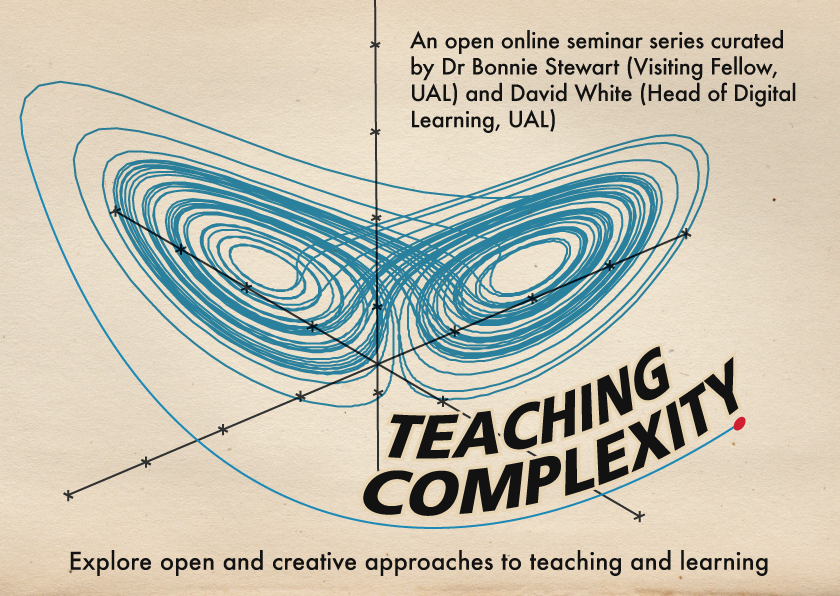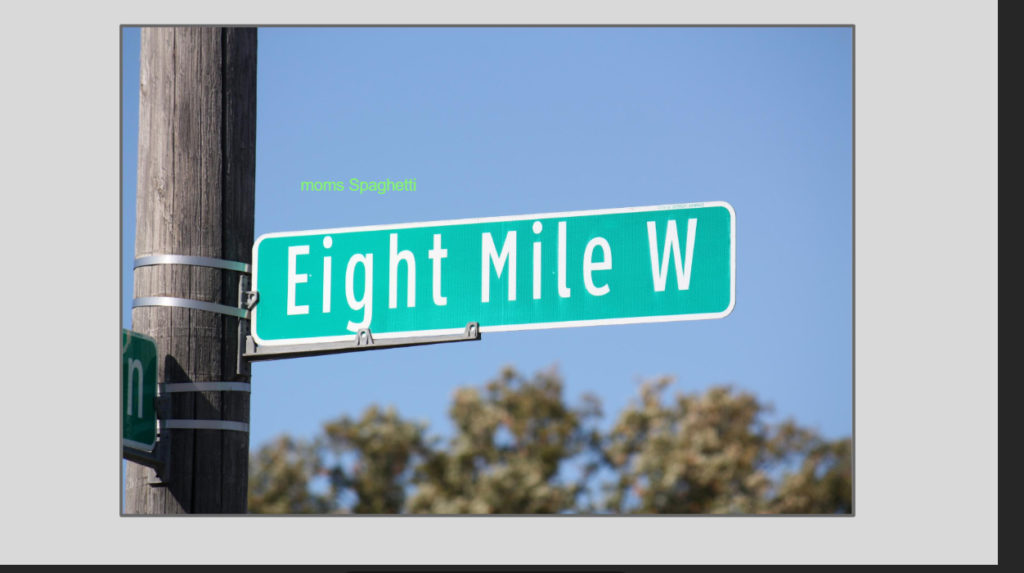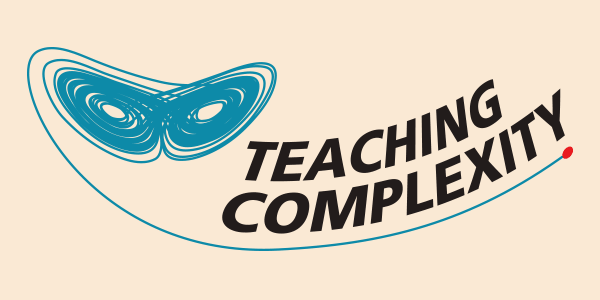One of the highlights of last year was designing and running a series of open, online seminars with our online Visiting Fellow, Dr Bonnie Stewart. The ‘Teaching Complexity’ series was 100% open, in the sense that anyone with a connection to the Web could attend for free. The territory the seminars explored was the complexity of the digital environment we now teach in and how we might respond.
The topics covered within the seminars all responded to the opportunities and challenges of the networked environment. A common theme being how to counter the creep of polarisation and support a diversity of voices within digital spaces.
One advantage of the seminars being open is that all of the materials (slides, recordings, comments etc) are available at the Teaching Complexity website which I created using our blogging platform. I’ve included a list of the seminars at the end of the post and know that quite a few people caught-up with them this way after the live ‘event’.

The motivation to run the seminars was two fold:
Understanding the new teaching environment
Responding to the complexity of the Web as a teaching and learning environment is an important topic to discuss. I now work on the principle that ‘All Courses are Blended Courses’ as I’d argue that any student, on any course, will spend significant amounts of time online. Some of that time will be spent discussing, or negotiating, the course with peers even were there is no, formal, online aspect to the curriculum. You’d be hard pressed to find a student who isn’t keen to develop their ability to navigate the Web for study or to make contacts which might lead to work. The Digital Creative Attributes we developed at UAL are a reflection of this but I realised that while I had clear principles in mind as we developed the DCAF I had not provided many examples of what a good response to the DCAF might look like in design terms. Hence Teaching Complexity.

A good example of open practice
It was clear that for some the Open Practice Values I introduced at UAL caused some confusion. I personally see my approach here as a failure of communication on my part with some useful institutional lessons learned. I spend quite a lot of time considering open approaches and feel part of a community of open practitioners, so I underestimated how alien this line of thinking can be to people who are mainly (and rightly) focused on keeping the wheels of the university turning. When I presented the Principles at committee they split the room, with some immediately seeing the relevance (both in the manner in which the university could connect outwards and in the way our colleges could collaborate more closely) and some clearly worried that this would be yet another, distinct, layer of work which would detract rather than enhance, day-to-day teaching (A dis-integrated view of Open Practice). Given this, the Teaching Complexity Seminars were my ‘Show not Tell’ example of what teaching which embodies the Open Practice Values can look like.
——————————————————-
Attendance and feedback
We had between 50-100 participants at each of the main seminars and more will have caught up with the recordings later. Those that responded to the evaluation questionnaire were mainly teaching staff, in roles overseeing or enhancing teaching or people involved in staff development of different forms. People attended from across the globe with the main locations being Europe and North America. Having been involved in this type of teaching quite regularly I’ve become a little blase about the geography involved and have to remind myself how incredible it is that we can facilitate these kinds of international moments so easily.
The feedback was almost universally positive and at times effusive. A number of participants commented that they have very little staff development opportunities at their institution so the seminars provided a rare moment for them to consider and discuss themes which were unlikely to appear in the normal flow of their work. I feel that working in an open mode is integral to my work, especially as I represent a large institution with the capacity to be outward facing. Given that, I hadn’t thought of the seminars as ‘generous’, but this is how many participants respond to them. Overall I would have liked to have seen more people from my own institution at the seminars but UAL tends to be attracted by creative arts rather than teaching themes. I need to put some more thought into how best to describe opportunities like this in a manner which resonates at home as it were.
Some key points I took away from the seminars:
Be explicit
Given that anyone could turn-up and type in a name of their choice there was always a risk that someone could be disruptive with no cost to themselves. My view is that this would be extremely unlikely unless the topic under discussion is contentious or the facilitator is particularly famous/notorious. I equate this to Wikipedia vandalism – yes, the articles on Trump, Iran or Transgender are likely to be the focus of edit wars and vandalism but articles on Contructivism or John Dewey are unlikely to get messed with, because where’s the fun in that? The Teaching Complexity seminars definitely fell into the latter category – as would most teaching scenarios. Even so, I made sure to introduce every seminar with a brief and friendly talk about the social contract of the space. We were there to explore complex themes through mutually supportive discussion. I also highlighted that the sessions were being recorded and would be made openly available. This, I felt, gave me the right to remove people from the room if they stepped outside of these bounds. We never came close to anyone breaking the trust of the room but I still think it’s worthwhile being explicit about social and collaborative expectations. If you’re upfront about this then any disruptive individual is, in some ways, excommunicating themselves through their actions and you mitigate being placed into a ‘policing behaviour’ role as it’s likely there will be, post-event, group consensus on removing people.
Is anybody with me?
Small moments of sharing go a long way in creating a sense of belonging online. For example, we would sometimes ask what the temperature was at participant’s locations with a notional prize for the highest and lowest (the range was always spectacular). The ‘live slides’ where everyone could write (or scrawl) a response to a question on screen on the whiteboard gave a powerful sense of being in the same, communal, space. In webinar type spaces like the one we were using it’s crucial for people to get a sense that they are co-present with others. This does not come for ‘free’ as it does in face-to-face environments, so these small moments of sharing become very important. The risk of people moving slides, drawing all over the screen or accidentally un-muting their mic at a random moment was more than balanced out by the inclusive atmosphere that giving people these options supported (we did have a few strange moments but they were all harmless). Giving everyone ‘moderator’ status by default was a good way of subverting the didactic design principle of the platform we were using (Blackboard Collaborate Ultra).
A favourite moment for me was when Dave Cormier asked people to play with the whiteboard while we waited to get started. This is the result:

This is a good example of responses to a ‘live slide’ question. One of the interesting aspects of this is how people started to highlight or draw around answers they felt were important as the seminars progressed. The messiness here creates a friendly atmosphere which somewhat counters the slightly sterile and inhuman feeling of the default webinar platform.

I also very much enjoyed how quickly somebody (in about 5 seconds…) wrote ‘Moms Spaghetti’ on the following slide (see the ‘classic memes’ section of pop-culture…).

Please talk while I’m talking
Building on the point above, I’m a huge fan of encouraging people to use the text chat while the seminar is in progress. Actually getting this going requires some facilitation in itself which is why all of the sessions would have a lead facilitator and a kind of support facilitator who could give some momentum to the chat and highlight interesting questions. When you have 50 or more people the chat can get quite lively and really helps the facilitators by giving a live indication of how well they are connecting with the group. All the facilitators for the seminars were experienced in speaking online so could respond to the chat as the seminar progressed. This is one of the distinct advantages of the online space over the face-to-face as it allows sessions to be discussed in the moment – it erodes the ‘expert broadcast’ aspect of online teaching in a very pleasing way.
If it could have been a video, you’re doing it wrong
I have a general rule of thumb that if, on reflection, a synchronous online event could have been a YouTube video then you have got the approach wrong. Why turn up ‘live’ if there is no interaction? Even though I was vocal about this in the planning stages, a few of the sessions had long sections of ‘just talk’. What I’ve subsequently realised is that these sessions were not actually all that long but that our concentration threshold is somewhat shorter in a webinar room than in a physical room. Some of that is to do with there being less to look at – less, or no, physical presence. It is also to do with the culture of the space, by which I mean that when we are in front of our laptops we are used to interacting quite often unless we are in ‘Netflix mode’. The differing socio-cultural expectations of online vs face-to-face are probably more of a factor than the notion of a concentration threshold as, by my estimate, it’s acceptable to speak for at least 20 minutes with no interaction face-to-face but this is probably reduced to around 7 minutes online. Beyond 7 minutes I suspect we start going into Netflix mode or getting distracted by the other tabs we have open.
Be clear it’s not about absorbing everything
Speaking to a couple of UAL colleagues in the following weeks I discovered that the seminars had been quite overwhelming for them, with ‘a lot going on’ at the same time (i.e. the facilitator speaking, parallel text chat, whiteboard interactions, voting and Tweeting). It was a useful reminder to me that I personally enjoy navigating, and reflecting on, multiple channels simultaneously but that this is not the case for everyone. So, perhaps my 7min threshold is too short and people need longer periods of ‘broadcast’ mode to be able to take in new topics. Overall I suspect the biggest cognitive shift for many is paying attention to the speaker while simultaneously keeping up with the text chat. That would certainly be overwhelming if you felt you had to take every detail in, so a message at the start explaining that the aim is not to absorb everything that’s happening on screen might help.
————————-
Learning from the seminars
The substance of the Teaching Complexity seminars was extremely interesting with sessions like Inclusive Spaces exploring ideas which are often not considered in digital contexts. Commonly the notion of ‘innovation’, which is often attached to digital approaches, avoids difficult thinking around inclusion and exclusion by implying that it’s going to change the way we interact so the problem simply won’t exist and therefore does not need to be confronted…
Beyond the ‘content’ of the seminars, I will be incorporating what I’ve learnt about the format of the sessions (the modes of interaction) into future work. This includes a project which is looking at transcultural arts education across an international partnership of arts schools and the development of more sophisticated ‘hybrid’ events which take place face-to-face and online in parallel.

1. Connected Teaching – Jan 8th 3-4pm GMT –
Recording and slides
Designing ‘connected’ teaching and learning which works on and offline.
Facilitators: Bonnie Stewart, Amy Collier, David White
2. Openness and Prestige – Jan 29th 3-4pm GMT
Recording and slides
Exploring how ‘giving stuff away’ and working openly online can be good for you and your students.
Facilitators: Bonnie Stewart, Catherine Cronin
— Digital fieldwork part 1 – Feb 5th 3-4pm GMT
Recording and slides
Get tooled up to undertake some exploratory digital fieldwork.
Facilitators: Matt Lingard, David White
3. Complexity and creativity – Feb 19th 3-4pm GMT
Recording and slides
Learn how to take a creative approach to complex subjects.
Facilitators: David Cormier, Tobias Revell
— Digital fieldwork part 2 – Feb 26th 3-4pm GMT
Recording
Sharing your digital fieldwork experiences.
Facilitators: Matt Lingard, David White, Sheldon Chow4. Inclusive spaces – Mar 5th 3-4pm GMT
Recording and slides
Ensuring digital teaching and learning welcomes a variety of voices
Facilitators: Bonnie Stewart, Maha Bali , Chris Giliard
